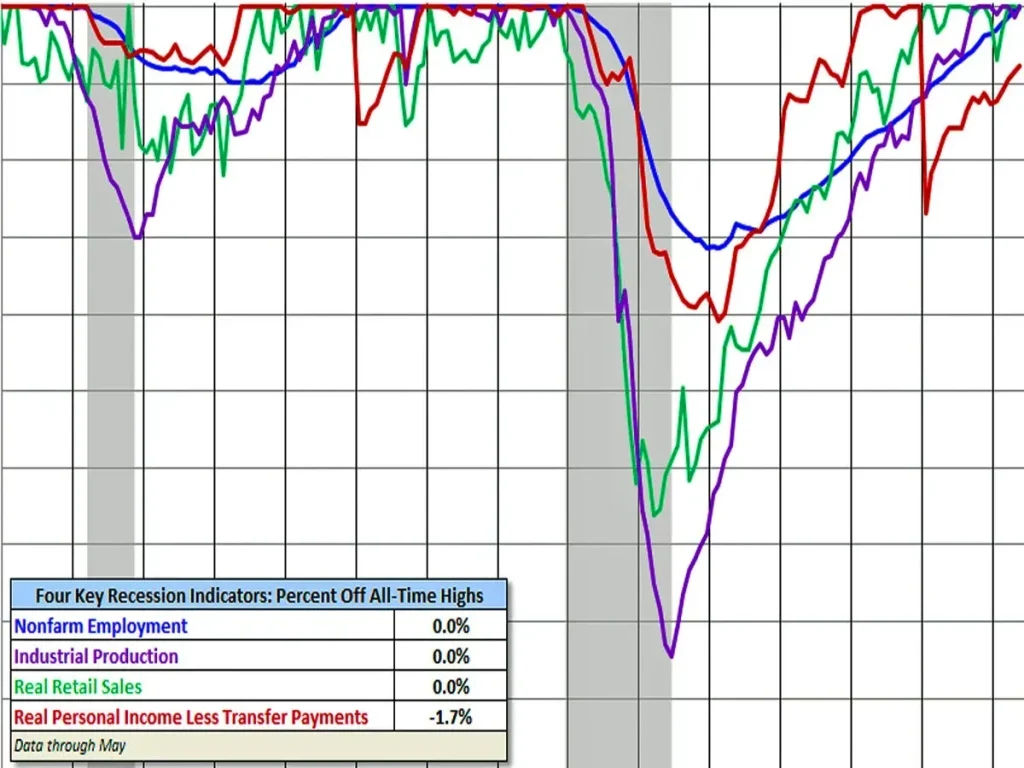Recession indicators are surfacing everywhere, suggesting a potential economic downturn on the horizon. Signs of a recession can manifest in various aspects of consumer behavior trends, such as consumers opting for budget-friendly alternatives and DIY solutions to save costs. Recently, the concept of ‘recession-proof gardening’ has become a popular topic, as individuals prepare to cultivate their own food amidst rising grocery prices. Furthermore, the ongoing impact of Trump’s fluctuating tariffs adds an additional layer of uncertainty, making it crucial to be aware of early warning signals. Understanding these recession indicators can empower individuals to adapt and strategize financially during turbulent times.
The signs of an economic slump are increasingly prevalent, reflecting a pervasive sentiment across society. These recession signals, which include shifts in spending habits and the rise of self-sufficient practices, indicate a growing concern about financial stability. Many are exploring alternative lifestyles, such as urban gardening, as a means of ensuring food security while navigating potential hardships. The societal landscape is transforming as people gravitate towards more frugal consumer habits, spurred by rising costs and uncertain economic policies. As individuals adjust their daily practices to mitigate the effects of potential downturns, recognizing these patterns becomes essential for preparedness.
Understanding Recession Indicators
Recession indicators are crucial signals that can help identify economic downturns before they fully manifest. Among the most telling signs is consumer behavior; analysts closely observe shifts in purchasing patterns, such as increased reluctance to spend on luxury items. For instance, a climb in the sales of second-hand goods often indicates that consumers are tightening their belts in anticipation of tough economic times. Furthermore, the rise of ‘recession-proof’ gardening, which focuses on self-sustainability through home-grown produce, has gained traction, suggesting that individuals are looking for ways to mitigate rising food costs and economic insecurity.
Additionally, the impact of external factors, such as policies under the Trump administration, notably the fluctuation in tariffs, has introduced further uncertainty into the economy. The imposition of tariffs has historically led to increased prices in everyday items, prompting consumers to alter their spending habits drastically. Such shifts are indicative of broader trends, as communities adapt to perceived threats – whether economic or cultural. By keeping an eye on these recession indicators, individuals and businesses can better prepare for impending challenges, ensuring they remain resilient amidst shifting economic conditions.
Signs of a Recession: Behavioral Shifts
Considering the signs of a recession, the most prominent changes are often found in consumer behaviors and spending trends. With rising prices driven by tariffs, people may start opting for more budget-conscious choices, significantly impacting local businesses and service providers. Reports from hair salons and cafes reveal a trend where customers choose less expensive options, affecting industries across the board. An increasing number of people are foregoing their regular visits to coffee shops in favor of brewing their own drinks at home, illustrating a shift towards frugality in daily life.
Additionally, the increase in law school applications can be viewed as another indicator of a shifting economic mindset. Young professionals, worried about job security and stable income, often return to education to secure safer career paths. Such behavioral shifts not only reflect individual anxieties but also signal broader societal trends that may hint at an impending recession, characterized by increased caution and a reevaluation of financial priorities.
Gardening as a Response to Economic Downturns
In times of economic uncertainty, gardening has emerged as a popular activity, often referred to as ‘recession-proof gardening.’ Growing one’s own food aligns well with frugal living, allowing households to cut down on grocery expenses during an economic downturn. The cultivation of staple crops such as tomatoes and kale builds resilience against rising food costs, simultaneously serving as a rewarding hobby that encourages self-sufficiency. Gardening is not only a practical solution for individuals facing financial strain but also a therapeutic outlet that promotes mental well-being.
This trend is further amplified by social media influencers and gardening enthusiasts sharing tips on optimizing home produce. Videos and articles dedicated to recession-proof gardens showcase how individuals can strategically select crops that yield high nutritional value and are easy to grow. This resurgence of agricultural practices isn’t merely a reaction to economic challenges; it reflects a growing awareness of sustainability and mindfulness regarding our food sources, appealing to a community increasingly concerned about environmental impacts as well as personal finances.
Cultural Reflections During Economic Crisis
Cultural expressions often mirror societal anxieties during an economic crisis, as seen through emerging entertainment trends. Nostalgic references – such as the revival of music and shows from previous downturns – can reflect the collective fear and uncertainty of living through financial hardship. As individuals seek comfort in familiar cultural artifacts, such as the recent resurgence of nostalgic albums or television shows, it becomes apparent that society might be grappling with a psychological retreat into the past. This aligns with the notion of the ‘hemline index,’ suggesting our cultural inclinations shift in response to economic climates.
Moreover, even memes shared on social platforms delineate collective sentiments regarding economic indicators, portraying a humorous yet poignant realization of the times. These cultural memes act as an interesting coping mechanism, allowing individuals to acknowledge and express their feelings concerning the economic downturn without overtly addressing the crisis head-on. By engaging in familiar and often humorous content, communities find solace among shared experiences, further reinforcing the sentiment that our economic realities influence collective emotional states.
Consumer Behavior Trends in a Turbulent Economy
The current consumer behavior trends exhibit a significant shift in attitudes towards spending as economic conditions fluctuate. Increasing tariffs and uncertainty surrounding government policies prompt consumers to become more discerning about the purchases they make. Shoppers are now more likely to prioritize essential items over luxury goods, leading to an uptick in thrift shopping and discount retailers. This behavior reflects an innate survival instinct as individuals seek to preserve their finances amidst possible financial fallout.
Research indicates that many consumers are also embracing minimalism and sustainability, choosing to invest thoughtfully in products that align with these values. As a result, brands that focus on ethical sourcing and sustainable practices witness increased loyalty from a consumer base scarred by recession fears. Understanding these shifts in consumer behavior and the underlying motivations can provide businesses with invaluable insights in strategizing their product offerings to meet the evolving demands of an anxious market.
The Psychological Impact of Economic Uncertainty
Economic downturns often leave significant psychological impacts on individuals and communities. The anticipation of financial instability can lead to heightened anxiety, driving people to adopt more cautious lifestyles. It’s not just about changing spending habits; entire social dynamics can shift as individuals prioritize security over spontaneity. The psychological burden may prompt younger generations, who grew up during the last recession, to seek stability through career paths seen as secure, such as law or health care, highlighting a cultural shift towards risk aversion.
Moreover, the spread of misinformation during turbulent times exacerbates feelings of uncertainty, creating an environment where people may struggle to discern reality. This can lead to a pervasive sense of distrust in institutions and societal norms. Recognizing the emotional toll of economic uncertainty is vital, as it enables communities to support one another through collective resilience initiatives, fostering an environment conducive to navigating challenges with strength and solidarity.
Trump’s Tariff Impact: Navigating Economic Challenges
The impact of President Trump’s tariff policies has been felt across various sectors of the economy, leading to increased prices for consumers. As these tariffs are enacted, consumers face higher costs for imported goods, ranging from electronics to everyday items. This ripple effect can cause significant strain, particularly for low-income households that may struggle to adjust to rising costs. Moreover, businesses reliant on imported materials often pass these costs onto consumers, further squeezing budgets.
As conversations around tariffs continue, it’s crucial to understand the broader implications for the economy. The economic downturn hinted at by rising tariffs has prompted a degree of uncertainty among investors, who find it difficult to gauge the long-term effects of such policies on market stability. Transparency regarding policy shifts can foster a sense of security; however, abrupt changes can lead to increased volatility, influencing both consumer confidence and overall economic health.
Alternative Strategies for Economic Resilience
In light of potential economic challenges, exploring alternative strategies for resilience becomes paramount. Communities are increasingly turning to self-sufficiency measures, such as local farming and community gardens, which not only provide fresh produce but also nurture social bonds. These initiatives encourage economic cooperation among neighbors and foster a sense of communal resilience, allowing families to depend less on fluctuating market prices for their food sources.
Another avenue for building economic resilience is the rise of digital platforms that facilitate peer-to-peer sharing of skills and resources. From barter systems to co-op memberships, leveraging local talents can mitigate costs associated with necessities, attribute significant value to community connections and enhance individual quality of life during economic instability. As communities band together, they reflect an age-old truth: collective effort serves as a powerful countermeasure against economic downturns.
Preparing for Uncertainty: Embracing Adaptability
Amidst looming economic uncertainties, adaptability is becoming a crucial skill for both individuals and businesses alike. The ability to pivot and reassess strategies in response to changing circumstances can mark the difference between thriving or merely surviving during challenging times. Those who cultivate resilience and flexibility in their economic practices stand better equipped to navigate the complexities of an unpredictable market, adapting to shifts in demand and adjusting operational strategies accordingly.
Furthermore, reliance on technology for real-time information and agile decision-making is an essential component of modern adaptability. Leveraging data analytics to gauge consumer trends and preferences allows businesses to stay ahead of the curve, ensuring they continually meet customer needs even during downturns. By fostering a culture of adaptability, individuals and organizations embrace the notion that uncertainty can be an opportunity for reinvention, growth, and success.
Frequently Asked Questions
What are some common signs of a recession that consumers should watch for?
Common signs of a recession include rising unemployment rates, declining consumer spending, and noticeable changes in consumer behavior trends, such as opting for cheaper services or goods. Additionally, increased applications to law schools and rising prices at cafes due to tariffs can also indicate an economic downturn.
How can gardening contribute to recession proof strategies?
Gardening can serve as a recession proof strategy by allowing individuals to grow their own food, which reduces grocery costs. Specific crops such as garlic, tomatoes, and kale are recommended for a ‘recession proof garden’, enabling people to become more self-sufficient and mitigate the effects of an economic downturn.
How do Trump’s tariff impacts serve as recession indicators?
Trump’s fluctuating tariff policies can create uncertainty in the economy, leading to higher prices for consumer goods. Changes in shopping behavior, such as increased interest in budget-friendly options or homegrown products, often arise as individuals respond to these economic signals, making tariff impacts a significant recession indicator.
What lifestyle changes signify an economic downturn in consumer behavior trends?
During an economic downturn, consumer behavior trends often shift to reflect tighter budgets. People may begin cutting back on non-essential spending, such as salon visits, and instead focus on DIY solutions. Additionally, the rise of home-based activities like gardening or making café-style drinks at home can indicate a collective shift towards recession-conscious living.
What is the ‘hemline index’ and how might it relate to recession indicators?
The ‘hemline index’ is an economic indicator suggesting that fashion trends, such as the length of skirts, can reflect economic conditions. In tough times, fashion may become more conservative, mirroring the nostalgia and caution observed during a recession. As consumer sentiment shifts in response to anticipating hard times, fashion often becomes a reflection of that mood.
How can staying culturally aware help identify recession indicators?
Being culturally aware allows consumers to recognize shifts in media, trends, and public sentiment that may signal a recession. An increased interest in nostalgic entertainment or shifts toward darker, more serious cultural products can indicate a prevailing mood of uncertainty and anxiety typical during economic downturns.
| Indicator Type | Example | Implication |
|---|---|---|
| Economic Behavior | Cheaper treatments in hair salons | Consumers are cutting back on non-essential expenses. |
| Trend in Education | Increase in law school applications | Young people are seeking more secure job prospects. |
| Cultural Indicators | Decline of coffee shop visits | Individuals are opting for homemade alternatives due to rising prices. |
| Consumer Behavior | Home gardening and foraging practices | People are preparing for economic hardships by becoming self-sufficient. |
| Social Media Trends | Memes identifying recession indicators | Highlights a collective anxiety over economic stability. |
Summary
Recession indicators are everywhere in today’s economic landscape, reflecting a growing anxiety among consumers and investors alike. From hair salons to home gardening trends, each sign points towards an emerging pattern of cautious behavior. As anecdotes of budget-conscious choices permeate the culture, it’s clear the uncertainty surrounding economic stability is influencing daily life. By recognizing various recession indicators, individuals can better prepare for potential challenges ahead.



